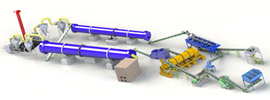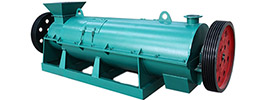The granulation process is a critical step in fertilizer production, significantly impacting product performance, cost, and application scenarios. Below is a detailed analysis of the advantages and disadvantages of various fertilizer granulation methods, translated into English while preserving technical accuracy and contextual relevance:
1. High-Tower Granulation
Process Principle: Raw materials are melted at high temperatures and sprayed from a height, forming spherical particles through surface tension, which are then cooled and sieved.
Advantages:
- Superior Particle Quality: Produces uniform, glossy particles with a distinct pore structure, enhancing appearance and resistance to caking.
- Uniform Nutrient Distribution: Ensures consistent nutrient content in each particle, enabling balanced release and high absorption efficiency.
- Fast-Acting Fertilizer Effect: Ideal for high-nitrogen formulations (e.g., 30-10-11), with rapid nutrient release and excellent solubility, suitable for topdressing.
Disadvantages:
- Formula Limitations: Maximum phosphorus content is approximately 15%, making it unsuitable for high-phosphorus blends. Biuret levels may approach the national standard limit (1.5%), requiring cautious long-term use.
- High Costs: Significant equipment investment and operational complexity, with frequent formula changes increasing production expenses.
- Environmental Sensitivity: Prone to moisture absorption and caking in humid summer conditions.
2. Drum Granulation (Rotary Drum Granulation)
Process Principle: Materials are agglomerated into balls under liquid-phase conditions through drum rotation and steam conditioning.
Advantages:
- Simple Process: Accommodates diverse formulations, particularly low-concentration blends.
- Low Cost: Minimal equipment investment (¥2-3 million per line), high daily output (280-500 tons), and short construction cycles.
- Versatile Applications: Effective for short-term crop topdressing in arid regions.
Disadvantages:
- Uneven Nutrient Distribution: Lower water solubility and utilization rates, with increased risk of nutrient loss.
- Poor Particle Integrity: Low hardness, susceptibility to pulverization and caking, and reduced storage stability.
- Regulatory Risks: Simplicity of the process may lead to misuse by unscrupulous manufacturers for substandard fertilizers.
3. Spray Granulation
Process Principle: Molten urea is sprayed onto a granulation device, forming particles through evaporative drying.
Advantages:
- Cost Optimization: Eliminates urea crushing steps; direct pipeline connection to urea plants reduces costs.
- Rapid Dissolution: Suitable for high-nitrogen formulations (nitrogen content >20%), with mature technology and high product qualification rates.
Disadvantages:
- Formula Constraints: Uneconomical for low-nitrogen blends; lower water-soluble phosphorus (≈80%) compared to ammoniation granulation.
- Aesthetic Issues: Potential color and size inconsistencies, though without impacting quality.
4. Ammoniation Granulation
Process Principle: Ammoniation reactions generate a compound fertilizer slurry, which is sprayed into a rotary drum granulator for shaping.
Advantages:
- Stable Quality: Uniform granulation, glossy finish, and high water-soluble phosphorus (≈95%) for efficient crop uptake.
- Safety: Relatively safe for seeds, suitable for base fertilizers, seed fertilizers, and topdressing.
- Broad Adaptability: Effective across various crops and soils, with notable yield increases.
Disadvantages:
- Scale Limitations: Better suited for small-scale production due to lower efficiency.
- Formula Rigidity: Requires viscous slurries or melts, limiting formulation flexibility.
5. Disc Granulation
Process Principle: Materials roll into balls in an inclined disc, aided by binding agents.
Advantages:
- Simple Equipment: Low investment, ideal for small-scale operations.
- Operational Flexibility: Adjustable binding agents improve balling rates.
Disadvantages:
- Low Efficiency: Limited to tens of tons per day, unsuitable for large-scale production.
- Formula Restrictions: Requires viscous additives, restricting use to low-concentration blends.
6. Blending Method (Bulk Blending)
Process Principle: Physical mixing of solid nitrogen, phosphorus, and potassium fertilizers in predefined ratios.
Advantages:
- Simplicity: Low cost and rapid production, with adjustable nutrient ratios.
- Speed: No chemical reactions required, enabling quick customization.
Disadvantages:
- Stability Issues: Prone to segregation during handling and application, with high risks of caking and moisture absorption.
- Nutrient Limitations: Most commercial products lack secondary and micronutrients, necessitating supplementary additions.
Comparative Summary and Selection Guidelines
| Criteria |
High-Tower |
Drum |
Spray |
Ammoniation |
Disc |
Blending |
| Fertilizer Speed |
★★★★ |
★★★ |
★★★ |
★★★★ |
★★ |
★★★ |
| Formula Flexibility |
★★ |
★★★★ |
★★★ |
★★★ |
★★ |
★★★★★ |
| Production Cost |
★★★ |
★ |
★★ |
★★ |
★ |
★ |
| Recommended Use |
Topdressing, High-N |
Short-term Topdressing |
High-N Blends |
Base/Seed Fertilizers |
Small-scale Low-N |
Customized Needs |
Selection Recommendations:
- Topdressing/High-N Demand: Prioritize high-tower granulation for speed and uniformity.
- Base Fertilizers/Seed Applications: Ammoniation granulation offers stability and safety.
- Cost-Effective Large-Scale Production: Drum granulation balances cost and capacity.
- Customized Formulations: Blending method provides flexibility but requires stability management.
Each method has distinct trade-offs between technical performance, economic viability, and operational scalability, necessitating a tailored approach based on raw material availability, market demands, and investment capacity.
 Send us a Email
Send us a Email Wulong Industrial Cluster
Wulong Industrial Cluster Have any question?
Have any question?



















